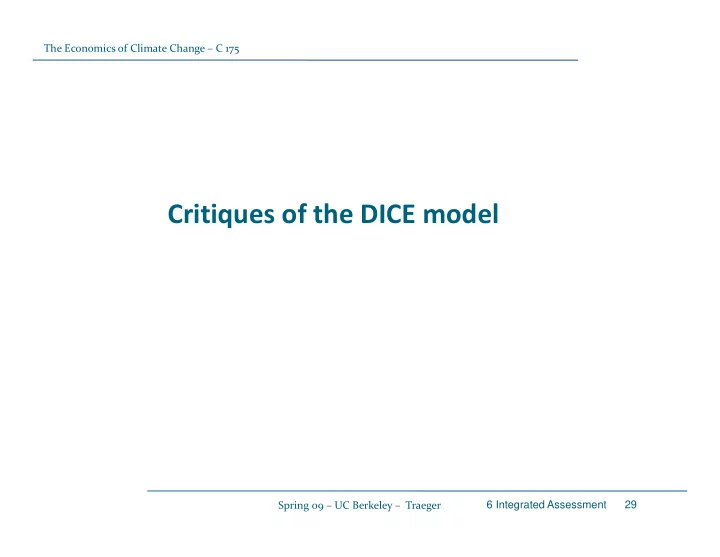

The Economics of Climate Change – C 175 Critiques of the DICE model Spring 09 – UC Berkeley – Traeger 6 Integrated Assessment 29
The Economics of Climate Change – C 175 Uncertainty in DICE 2007 The ‘uncertain’ run of DICE takes 100 random draws of the uncertain parameters and runs the (once parameters are drawn deterministic) model for each drawn parameter combination model for each drawn parameter combination ‐ > Only captures current uncertainty over parameters No uncertainty other than over parameters (like economic shocks) No learning No Knightian Uncertainty Spring 09 – UC Berkeley – Traeger 6 Integrated Assessment 30
The Economics of Climate Change – C 175 Recall In our section on Discounting and Sustainability we discussed: Instead of modeling one aggregate consumption good, model environmental goods x E AND produced goods x P AND the fact that both goods are not perfect substitutes and environmental quality directly impacts welfare: environmental quality directly impacts welfare: 1 1 E . 5 P . 5 E . 5 P . 5 1 ( ) ( ) 1 ( ) ( ) x x x x E P E P 0 0 1 1 ( , ) ( , ) W U x x U x x 1 1 2 2 1 1 1 1 1 1 1 1 And we learned that instead of a common discount rate we could derive r E = ρ + θ ( .5 g E + . 5 g P ) ‐ ( .5 g P ‐ . 5 g E ) r P = ρ + θ ( .5 g E + . 5 g P ) + ( .5 g P ‐ . 5 g E ) Spring 09 – UC Berkeley – Traeger 4 Discounting 31
The Economics of Climate Change – C 175 Separating Environmental and Produced Goods Source: Sterner & Persson (2008), An even Sterner Review: Introducing Relative Prices into the Discounting Debate. d i l i i i h i i b Spring 09 – UC Berkeley – Traeger 6 Integrated Assessment 32
The Economics of Climate Change – C 175 Critique of Damages in DICE Hanemann (2008) discusses the DICE 99 estimates for the US (for the 2.5°C, qualitatively similar to DICE 2007, though 07 slightly higher) Aggregation: Average global temperatures (DICE) vs. statewise/local temperatures t t Year ‐ Average (DICE) vs. winter and summer Cites a climate model that delivers following increases: 2°C globally, 3.3°C California, 5°C Central Valley Californian winter 2 3 °C but summer 4 6 °C Californian winter 2.3 C, but summer 4.6 C No risk aversion in damage evaluation except for catastrophic impacts Spring 09 – UC Berkeley – Traeger 6 Integrated Assessment 33
The Economics of Climate Change – C 175 Damages in DICE: Agriculture Agriculture: DICE neglects nonlinear effect of temperatures on crop yields: A degree more can sharply reduce crop yield Oversimplification in comparing cropland, precipitation and temperatures: p Some of richest farmlands in US in California and Arizona These are also driest and hottest areas Thus appears that dry and hot is good for crops However, these regions are irrigated with water from elsewhere Evapotranspiration of plants increases water demand at higher Evapotranspiration of plants increases water demand at higher temperatures Spring 09 – UC Berkeley – Traeger 6 Integrated Assessment 34
The Economics of Climate Change – C 175 Damages in DICE: Water Climate change not only changes precipitation level, but also: Water storage in form of snow Ground cover in the watershed: E.g. wildfires can reduce forest cover accelerating runoff Water consumption by ground cover in watershed Likely to face less frequent but more intense rainfall Drier soil faster runoff Drier soil, faster runoff Can have more floods in winter and drier summers Sea ‐ level rise: Neglects that more US population living close to coast increases Neglects that increasingly valuable assets at risk at coast Spring 09 – UC Berkeley – Traeger 6 Integrated Assessment 35
The Economics of Climate Change – C 175 Damages in DICE: Energy and Health Energy: DICE nets out reduced use in winter with increased use in summer However: Demand increases much steeper with high temperatures than it falls with low temperatures Also: Summer high temperature demand (AC) generally in peak hours Also: Summer high temperature demand (AC) generally in peak hours Health: DICE assumes that reduction in cold spell deaths in winter cancels with heat waive deaths in summer More recent epidemiologic studies show that heat waive deaths far M id i l i di h h h i d h f larger Spring 09 – UC Berkeley – Traeger 6 Integrated Assessment 36
The Economics of Climate Change – C 175 Damages, Alternative Value Suggestions for US and 2.5°C Billions of (1990 ‐ ) USD Billions of (1990 ) USD DICE 99 Hanemann (suggestions) Agriculture Agriculture 4 4 15 15 Energy 0 5 Water 0 10 Sea Level 6 35 Market Subtotal 11 60 Health 2 10 Amenities ‐ 17 ‐ 5 Settlement, 6 11 Ecosystems y Extreme and 25 25 catastrophic events Nonmarket Subtotal Nonmarket Subtotal 17 17 41 41 Total 28 113 Spring 09 – UC Berkeley – Traeger 6 Integrated Assessment 37
Recommend
More recommend